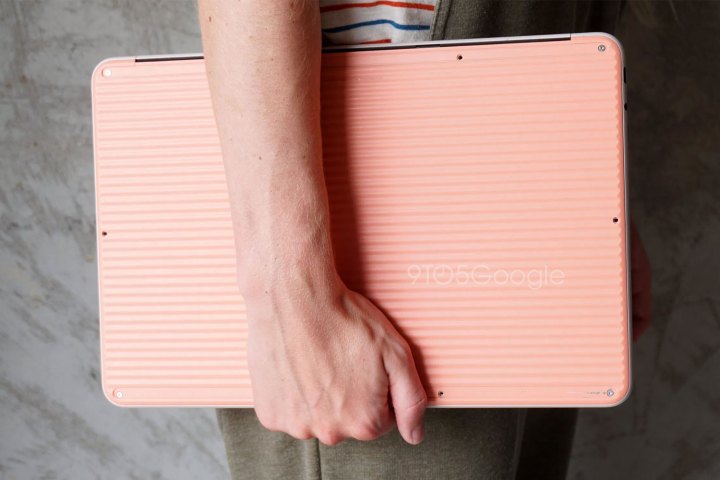
Google is expected to unveil a number of new products in its Pixel line at its October 15 hardware event, but we may have gotten a sneak peek at one of the new devices a little early. A prototype of the Pixelbook Go has shown up in the hands of 9to5Google, and though its hardware makeup is quite typical, it’s not your average notebook in terms of looks.
Google’s own efforts in the Chromebook space have been hit-and-miss over the past few years. Its Pixelbook still remains one of the most powerful Chromebooks available, and it helped kick off a trend of premium Chromebooks among other manufacturers. But its Pixel Slate wasn’t anywhere near as exciting, so most observers have been expecting a Pixelbook sequel at the October hardware event. Instead, Google appears to be moving in a new direction. One that’s more aestheticly focused, more affordable, and certainly more Google.
The Pixelbook Go is a 13.3-inch clamshell Chromebook with a unibody hinge and two color options. It comes in “Just Black” and “Not Pink,” and features a ridged underside that should add extra grip for carrying, improve airflow underneath the device, and increase the laptop’s surface area for greater passive cooling. It is a unique aesthetic too, which could help the Go stand out from the crowd when in transit. When the lid is popped open, it looks less distinct, with a MacBook-esque style to it.
The display is 1080p, with a 4K option, and comes in a 16:9 aspect ratio. Each screen has modest bezels and a full glass front, so there’s a clean look to it. The keyboard is said to be excellent to type on and features the squared keycaps of the Pixelbook, rather than the rounded ones we saw on the Slate. The touchpad is large and roomy and supports modern gesture controls.

Under the hood, the Pixelbook Go offers a wide range of hardware options, making this a Chromebook that can both succeed the Pixelbook, and also offer something for those with more modest budgets.
Since the information that was provided doesn’t specify what generation of Intel CPUs, we are left to speculate. We would expect the Pixelbook Go to utilize 10th-generation Ice lake processors, but the mention of a Core M3 model raises questions, as the 10th-generation doesn’t technically have any Core M3 chips. They’ve been renamed as i3, with an extra 0 in their name to differentiate them.
What we could be looking at is an eighth-generation Core M3 at the low end, and 10th generation Core i5 and i7s at the high end. It’s also possible that these are all 10th-generation and Core M3 is just a placeholder name for the entry-level 10th-gen Core i3. There’s a slight change they’re all eighth-generation too, but that seems unlikely considering how dated those chips are at this point.
Memory comes in 8GB or 16GB flavors, with storage options of 64GB, 128GB, and 256GB. The 9to5Google prototype also included a Titan C security chip, and features two USB-C ports with LED indicators, as well as a 3.5mm headphone jack. It also supports “normal,” Wi-Fi and Bluetooth we’re told, which we surmise equates to Wi-Fi 5 and Bluetooth 5.0.
Other features include two forward-facing speakers and a 2MP webcam that sits in the top-most bezel of the display. There are also the usual Chromebook features, like Chromebook keys and a dedicated Assistant key.
The only thing we aren’t privy to is price. With such broad hardware options, it’s likely that we’ll see equally varied pricing. The Pixelbook started at $999 with a Core i5 CPU, so we would expect the Core M3 model of this device to be noticeably cheaper than that. Core i7 models with 4K screens could cost far more, however.
Battery life is also a real unknown and may well vary with the release version, anyway.
We’ll have to wait until October 15 to learn more about this device, but with as expansive a leak as we’ve seen here, Google may release more information before then.



